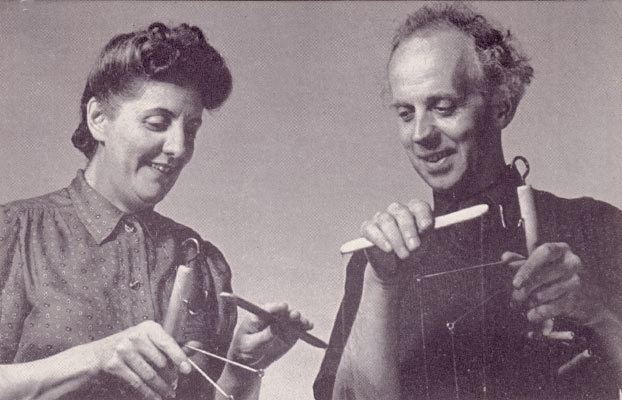Name Waldo Lanchester Role Puppeteer | Died 1978 Siblings Elsa Lanchester | |
 | ||
Books Hand puppets and string puppets Parents James Sullivan, Edith Lanchester | ||
Marionette Pt 4. Carmen Miranda (Copy of Waldo Lanchester puppet)
Waldo Sullivan Lanchester (1897–1978) was a puppeteer who founded the Lanchester Marionettes (1935-1962), a puppet theatre that was based in Malvern, and later in Stratford-upon-Avon. He wrote a book on the revival of puppeteering and commissioned George Bernard Shaw to write his last completed play Shakes versus Shav in 1949. In 1952, Donald W. Seager wrote that "Waldo Lanchester has consistently been associated with all that is best in the puppet theatre." Archibald Henderson called him "England's greatest puppetmaster."
Contents
- Marionette Pt 4 Carmen Miranda Copy of Waldo Lanchester puppet
- Belsa Lanchester marionette is missing
- Early life
- Puppetry career
- Shakes versus Shav
- References

Belsa - Lanchester marionette is missing
Early life
Lanchester was the son of James "Shamus" Sullivan (1872–1945) and Edith Lanchester (Biddy) (1871–1966). His sister was the actress Elsa Lanchester. Two of the earliest puppets he created were named "Baldo and Belsa", the pet names of himself and his sister Elsa. The family were considered Bohemian, and refused to legalise their union in any conventional way to satisfy the era's conservative society.
Puppetry career
Lanchester and his wife Muriel became interested in the puppetry revival of the early 20th century pioneered by H.W. Whanslaw, whose book Everybody's Theatre was published in 1923. He joined Whanslaw, to found the British Puppet and Model Theatre Guild. They founded the Whanslaw-Lanchester Marionettes a year later, based at the London Marionette Theatre in Stamford Brook. According to the Victoria and Albert Museum, "together they evolved aspects of marionettes such as the vertical control and new types of joints and methods of balancing. The London Marionette Theatre was the first to broadcast puppets on television, making nine broadcasts from the Baird Studios in 1933".
The Lanchesters branched off from Whanslaw to open the Lanchester Marionette Theatre at Foley House, in Malvern, in 1936. In 1937 he wrote Hand Puppets and String Puppets in which he argued for the teaching of puppetry to children as it "develops the power of initiative, teaches skillful use of tools, paint brush, and needle, makes practical use of historical research for costume design and architecture. Stage fright is banished, the children being only too eager to take part behind the scenes." He created a wide range of puppets used to perform Circus and Underwater Ballet stories, which were seen by the young Princess Elizabeth at Buckingham Palace in 1938. During World War II, the Lanchesters toured England with their puppets for the Entertainments National Service Association (ENSA).
Lanchester was keen to preserve the history of puppetry. He rescued Victorian puppets from potential destruction. In tandem with his puppet theatre, he ran a toy shop in Henley Street, Stratford-upon-Avon.
Shakes versus Shav
Bernard Shaw had shown an interest in marionettes throughout his life. Lanchester showed Shaw two puppets portraying Shakespeare and Shaw, asking Shaw to write a short drama for them. Having seen the performances of the Lanchester marionettes over the years, Shaw agreed to write Shakes versus Shav for the company in 1949. Lanchester carved the six marionettes (heads were carved by Jack Whitehead) and Muriel costumed them, having sought advice from Scotland on the correct tartans for the puppets representing Rob Roy and Macbeth. The Shaw puppet is now housed in the George Bernard Shaw Museum, Shaw's Corner, at Ayot St Lawrence, the Shakespeare puppet is in the Shakespeare Birthplace Trust and the other four puppets - MacBeth, Rob Roy, Captain Shotover and Ellie Dunn - are in the Staffordshire County Museum at Shugborough Hall.
